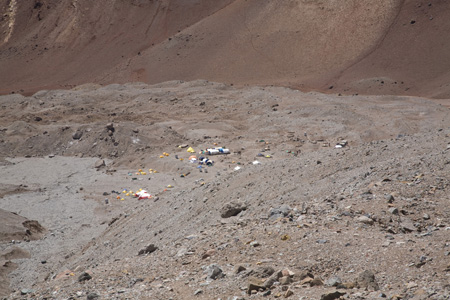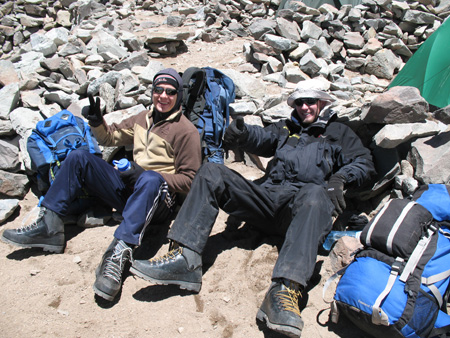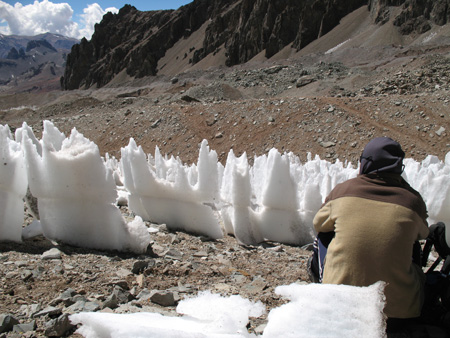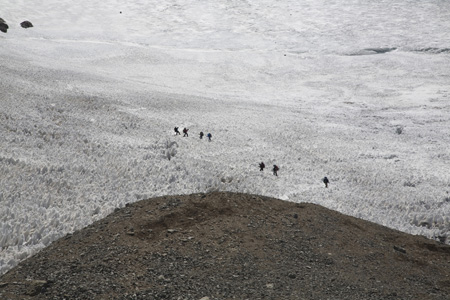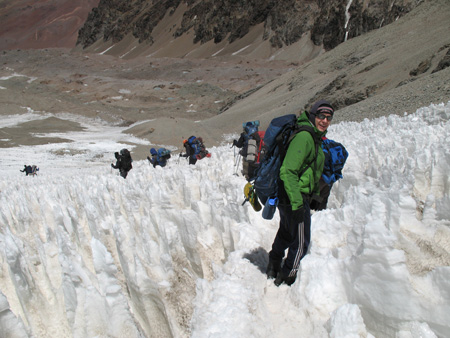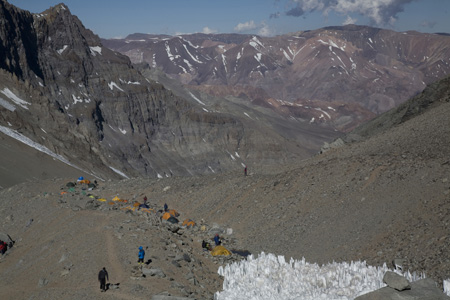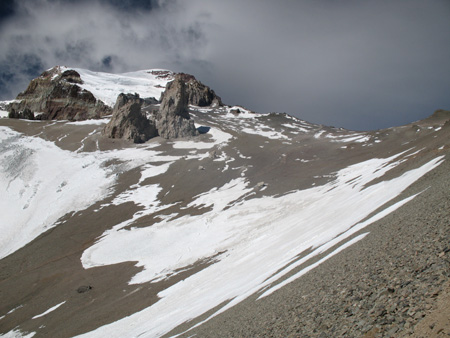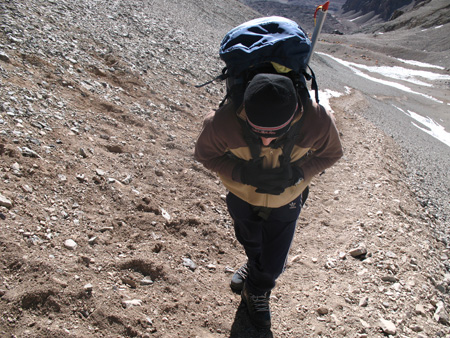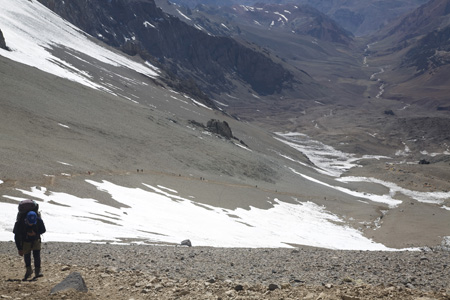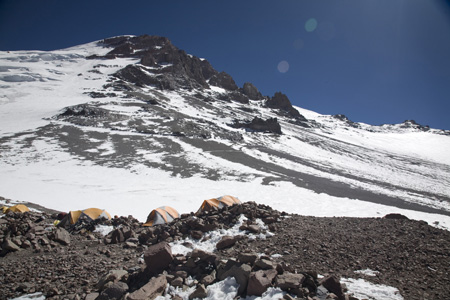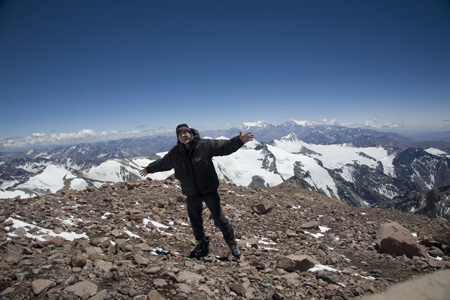Aconcagua: The High Camps
Once we reached base camp we had a day of rest, and we used it to go visit the camp doctor. Everybody that wants to ascend to the summit needs to see this doctor, who will measure your pulse, blood pressure, listen to your breathing, and all that needs to be done to make sure you are acclimatizing well. This doctor has the power to tell you that you are not allowed to go any further, and there were people that had to stay longer at base camp before they were allowed to continue (and even some that made it no further at all).
Going higher after base camp involves staying at two “high” camps before reaching the summit. The idea was to reach each camp with some gear, dump it, and then go back down to sleep, before going back up and staying for good. This “climb high sleep low” idea is a good way to acclimatize to altitude.
This first picture is looking back at base camp on the way to camp 1. While it’s a pretty big place considering how much effort it takes to get things there, it is dwarfed by the surrounding mountains once you go up a little higher.
Climbing to these high camps is much different than the type of hiking I am used to in Canada. In Canada I usually only go on day trips, travel light, and go up and down pretty quickly. Here we are carrying much more weight (both on our backs and in the gear we are wearing), we walk slowly, taking small yet determined steps, focusing on breathing, etc. In the above picture you can see Emil and myself taking a break; my pack was so heavy that every time we stopped and I took it off, I felt like I could flap my arms and fly away! Also notice the boots we are wearing, these weigh about 1.5 kg EACH BOOT!
The above picture shows me resting beside some penitentes, by far the most interesting feature I have seen on any mountain. Basically it’s what look like upside-down icicles, but are right in the snow we walk through. The picture below shows a whole mountain side full of penitentes, and we had to make our route right through it. Having to blaze a new trail through these things would be very difficult and time-consuming, but luckily there was already a trail we could follow.
Below you can see me among these penitentes as we are descending to base camp after having dumped some stuff at camp 1. And yes, those are flip-flops I have strapped to my backpack, I was using them as high as camp 1 to give the old feet a break from closed shoes!
Camp 1, 5000m. It is staying at this camp that made me appreciate all the things I took for granted at base camp. I guess this would be a good time to introduce the ‘human waste strategy’ that the parks has in place.
In all the camps below camp 1 there have always been outhouses, and the waste from them was flown out by helicopter to make sure it doesn’t start building up inside the park. I must admit that it’s good to know the money I paid for my permit is going toward things like that. At the first stop Las Lenas they even had porcelain toilets that flushed! But that is a long way down from camp 1… Anyways, as part of the permitting process, everyone receives two bags that they need to later return, or get fined. One is for garbage, the other one is for ‘number two’. So, once at camp one and above, going to the bathroom for number two involves squatting over a plastic bag. Now I will not get into too much detail but just imagine trying to go when there is heavy wind threatening to blow the bag away.
Just to comment on the picture above, what you see is camp 1 with the little line of tents, and where the person in red (who happens to be Kerry from our expedition) is heading up is where the ‘bathroom’ is. You will have to take my word for it that it is one of the most beautiful views from a bathroom that I have ever seen!
We did have some adventures at camp 1, mainly involving waking up to a tent that had flooded overnight and then frozen, and I had to use my ice axe to pick out my bag that had been left just outside overnight.
On to camp 2. The picture above shows the view looking up to more or less where camp 2 should be, at the top of the saddle and then a little to the left, behind those two jagged teeth sticking up. Above those we can see the Polish glacier, which is an alternate route, more direct but also much more technical, longer, and pretty much only for those hard to the core.
The next picture above does a great job showing the process of going up the mountain at these higher elevations. Notice how small my steps are, just one foot right in front of the other. Head down, not really looking at the view, just concentrating on walking, on breathing, on moving forward. In the back on the right you can see camp 1 in the background, which once again does not get appreciated until reaching the one higher.
On this next picture above we can see about three days worth of walking. The valley in the background was the last day of hiking to get to base camp. Then there’s the walk from base camp to camp one, of which we only see camp one in the background. Then there’s the route we’re on right now, from camp one to camp two, with the trail clearly visible.
Finally, camp 2! We reached it for the first time on January 15, 2009, just to drop some stuff off, and the second time a day later, to stay as long as necessary to make the summit. You can see the snow line going up and to the right, this is the route for the summit attempt. Or there’s the alternate route on the left, straight up the Polish glacier, but I did not see one single person try to go up that way in all the time we spent at camp 2.
And finally just a little clowning around at camp 2, enjoying the view that was once again better than at the previous camp. Already I felt like it was the top of the world, but there was still over 1000 vertical meters to go.
Make sure to stay tuned for the next installment, as we push to the summit…
